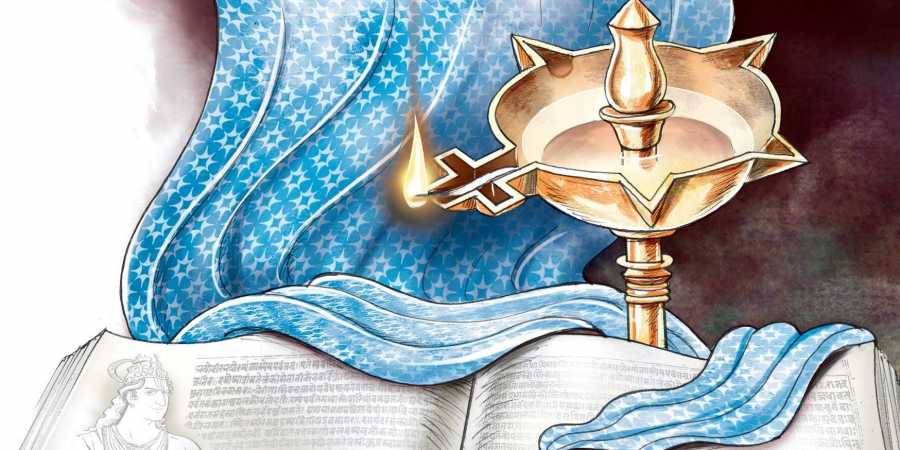READING RAMAYANA AS A FEMINIST EPIC

The epic portrays a society where women were free to exercise their choices, irrespective of whether they lived in a hermit’s abode or a palace.
The drivers of the Ayodhya movement may have lent the crusade a masculine momentum in popular imagination, but the epic’s core beats with a feminist heart led by ‘fierce’ women and ‘gentle’ men who drive the plot to make the Ramayana one of human civilisation’s earliest odes to the utopias of feminism. Feminism is defined as organised activities for women’s rights and interests, guided by theories of political, economic and social equality of the sexes.
A feminist is ‘a person who supports the belief that women should have the same rights and opportunities as men’. But these post-mid-nineteenth century noun insertions and their parameters are increasingly getting used for modern re-imaginations of leading lady characters in the Ramayana, like Kaikeyi, Sita, Tara, Surpanakha or Mandodari. How inspiring are these women as reclaimed icons for contemporary feminism? Can their societies and male counterparts be termed feminists-in-retrospect?
The Ramayana unfolds across a robust landscape led by multiple women characters, beyond its heroine Sita. The epic imagines a society where choice—social, marital, political and spiritual—was as much an area of access for a desiring woman, as the man, irrespective of whether she lived in a hermit’s abode or a palace.
Kaikeyi, Sita, Tara and Mandodari stand alongside their powerful husbands, never blind followers, heeding the counsel of their mind always—wrong or right. It is Rama who conducts the Ashvamedha Yagna in the shadow of his abandoned wife’s gold statue to lend the sacrifice sanctity and spectacle. Kaikeyi, a warrior queen, as the charioteer of her husband King Dasharatha, steers him to safety in a ferocious battle between the Devas and the Asuras. The act gets her the two boons that trigger the events leading to the epic’s first dramatic event—Rama’s exile.
Rama’s confrontation with Ravana, the epic’s second major turn, is triggered by another warrior princess Surpanekha’s lust of a ‘married’ Rama. The third major catalyst event leading to the eventual finding of Sita and the climactic Rama-Ravana battle was possible because the queen of Kishkindha, Tara, had advised her husband Bali to only banish and not kill Sugriva in their duels for the monkey kingdom. Before dying, Bali insists upon Sugriva to consult Tara on all decisions of statecraft as ‘her advice never goes without effect’. Like a hero’s wife, Tara mourns Bali’s death and refuses the Kishkindha throne when offered to succeed her dead husband. She opts for Sugriva’s kingship with her son, Angad, as the heir apparent. Her tact comes to the fore again when Sugriva sends her to pacify a raging Lakshmana, upset over the latter’s forgetting his promise to start searching for Sita.
Mandodari too, never shies away from giving sane counsel to the ferocious Ravana, constantly urging him to return Sita with honour. But when the war comes upon their Lankan capital, she doesn’t abandon her husband, as his blood brother Vibhisana did.
Marriages, though facilitated by fathers, be it of Sita or her sisters, or Mandodari (the daughter of Asura-king, Maya)—the daughters’ willingness is always sought. Ramayana’s women—whether driven by love, lust or high-purpose—never shy away from articulating choice and are rarely restrained by their male counterparts. Rama indulges Sita’s ‘silly’ wish for the golden deer while knowing that it was a trap. Of the three males who try coveting women against their will, Ravana and Bali get killed, and Indra is cursed.
Though the Ramayana effects categorical punishments against any violation of woman, none of the women, from queen Kaikeyi to ascetic Anasuya show any need for male protection or incapability for self-defence. Sita, is acknowledged in Valmiki’s Ramayana for her ability to ‘reduce Ravana to ashes through the fire of her chastity’ alone. She, however, resists the power to not deprive ‘Rama’s arrow from its legitimate glory’. Equal opportunities and a warrior’s disposition are evidenced, to greater degree among men and women in the Asura community, where women soldiers are neither a rarity nor a surprise. The gatekeeper of Ravana’s golden city at its sea frontier is a woman called Lankini; the caretaker of his most precious possession, Sita in the Ashokvan, is the brave and compassionate, Trijata; while Ravana’s grandmother, demoness Tadaka, lorded over forests bordering his empire.
Beyond the epic’s politico-royal landscape, its spiritual scape of forests and ashramas too features strong-willed women in the ‘ascetic-like’ Anasuya, Shabari and Swayamprabha. The latter two lead single, independent and fulfilling lives by choice.
Unlike their counterparts from subsequent epico-literary creations from the Indian subcontinent or other cultures, Ramayana’s women, while covering the entire spectrum of female needs, roles, aspirations and identities get rarely judged, if their wants are not unfair or in conflict with the fundamental rights of another. Most importantly, they are skilled in areas that later came to be seen as male-exclusive, such as physical combat and austerity.
The essentials of the feminism movement—equality of rights and opportunities—were a choice available, exercised and enjoyed by each of the epic’s women characters. This ‘right to equality and opportunity,’ a naturally accorded choice to men and women in the epic, is perhaps the essence edge that made their ‘age’ a Yuga of Satya or Truth.
https://www.newindianexpress.com/opinions/2019/apr/08/reading-ramayana-as-a-feminist-epic-1961567.html?fbclid=IwAR2vbBH3GMGROvgstc8zSbDd3Azhs1heOs9dd0CxTSNFCNdi2O3j-kY9pI0


Comments are closed.